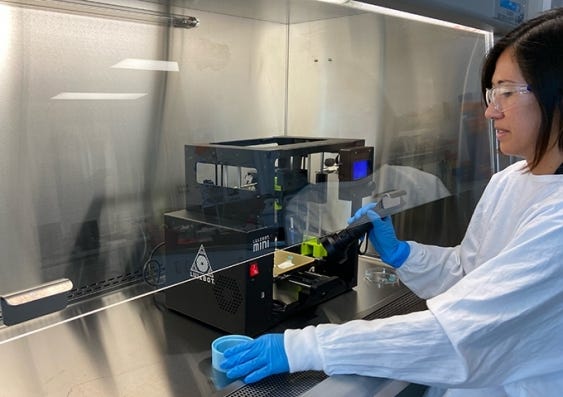A process developed by researchers in Australia is simpler and less toxic than the current ways to create material suitable for human implants.
May 15, 2021

Researchers have made it easier to fabricate bone-like materials for surgical use through 3D printing with the development of a ceramic-based ink that includes living cells.
Scientists from the University of New South Wales in Australia developed the ink, comprised of calcium phosphate, that allows for bioprinting of material that can be used to repair damaged bone tissue, right in the place where the bone needs repairing, they said.
While this in and of itself is not completely novel, the process can be deployed at room temperature and without the use of toxic chemicals or radiation, said Iman Roohani from UNSW’s School of Chemistry, who led the research.
“It could be used in clinical applications where there is a large demand for in situ repair of bone defects such as those caused by trauma, cancer, or where a big chunk of tissue is resected,” he said in a press statement.

Reducing Complexity
A new technique developed by researchers called ceramic omnidirectional bioprinting in cell-suspensions (COBICS) facilitates the new process. COBICS allows for the printing of bone-like structures that become hard in mere minutes when placed in water, said Associate Professor Kristopher Kilian, who collaborated with Roohani on the work.
The process itself creates a dry material “that is then brought into a clinical setting or in a laboratory, where they wash it profusely and then add living cells to it,” he said in a press statement.
This is a welcome diversion from current techniques to create artificial bone for implants, which require a complex laboratory process that uses high-temperature furnaces and toxic chemicals, Kilian said.
The process works because the ink was developed in a microgel matrix with living cells, Roohani explained. This creates a scenario in which the material forms a structure similar to the natural building blocks of human bone, he said.
“The ink is formulated in such a way that the conversion is quick, non-toxic in a biological environment and it only initiates when ink is exposed to the body fluids, providing an ample working time for the end-user, for example, surgeons,” Roohani said in a press statement.
Medical Applications
This combination of ink with the substance containing living cells enables in-situ fabrication of bone-like tissues for a number of applications, including bone tissue engineering, disease modeling, drug screening, and in-situ reconstruction of bone and osteochondral defects, he said.
Researchers published a paper on their work in the journal Advanced Functional Materials.
The team reports interest in the process from both the surgical and medical-technology manufacturing communities, which both can benefit from new opportunities it creates for both treatment and repair of bone tissue, researchers noted.
“This advance really paves the way for numerous opportunities that we believe could prove transformational -- from using the ink to create bone in the lab for disease modeling, as a bioactive material for dental restoration, to direct bone reconstruction in a patient,” Kilian said in a press statement.
The team will next perform tests in animal models to see if the living cells in the bone-like constructs continue to grow after being implanted in existing bone tissue.
Elizabeth Montalbano is a freelance writer who has written about technology and culture for more than 20 years. She has lived and worked as a professional journalist in Phoenix, San Francisco, and New York City. In her free time, she enjoys surfing, traveling, music, yoga, and cooking. She currently resides in a village on the southwest coast of Portugal.
About the Author(s)
You May Also Like



